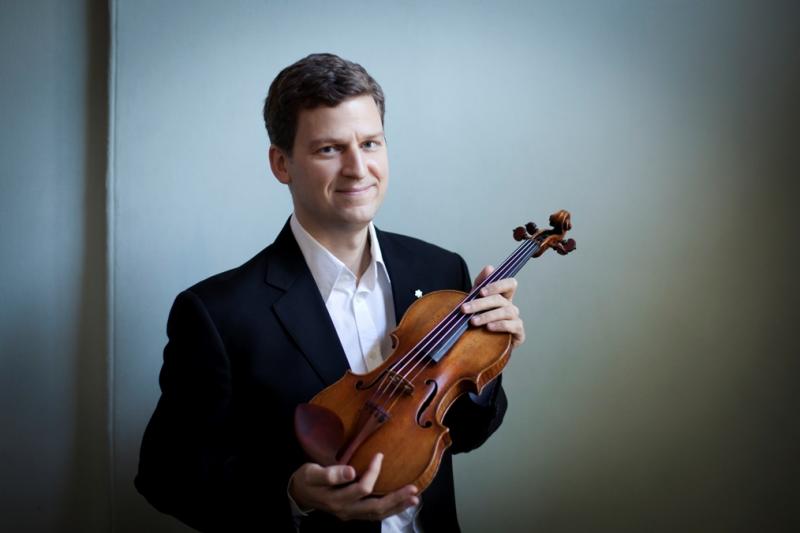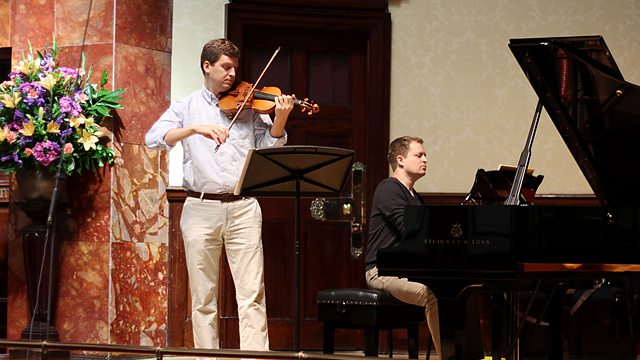Ehnes, Armstrong, Wigmore Hall | reviews, news & interviews
Ehnes, Armstrong, Wigmore Hall
Ehnes, Armstrong, Wigmore Hall
Flawless violin-and-piano duo in rich programme of works from around 1915

Violinists either fathom the elusive heart and soul of Elgar’s music or miss the mark completely. Canadian James Ehnes, one of the most cultured soloists on the scene today, is the only one I’ve heard since Nigel Kennedy to make the Violin Concerto work in concert, in an equally rare total partnership with Elgarian supreme Andrew Davis and the Philharmonia.
In their smart suits and ties, these two looked like men from the City. But they never had to apply the hard sell to their intelligent sequence. As in the last of Sakari Oramo’s Nielsen-centric concerts on Saturday, the concept was a quartet of works composed around the same time, in this case the hundred-year-old mark, hugely various so as not to overload a late romantic strain. While the Elgar Sonata was perhaps the work with the greatest personal depth, two movements either side of the interval emphasized an almost hallucinatory imagination both in the music and the performance.
 Armstrong (pictured right) has a musical personality to match the heavyweight Russians, producing an enormous sound when necessary, but always rounded, and always fine-tuned to the needs of his duo partner in flawless synchronicity. He needed the weight for the finale of Respighi’s B minor Sonata, a stunner after two not especially original movements: a Passacaglia which is to the violin-and-piano repertoire what the same form is to the conclusion of Brahms’s Fourth Symphony and clearly modelled on its inspiration. The violin, which Ehnes keeps tonally sweet and bright even when fullest of tone, rides the imposing double octaves and solemn chords of an amazing piano part, equally amazingly played.
Armstrong (pictured right) has a musical personality to match the heavyweight Russians, producing an enormous sound when necessary, but always rounded, and always fine-tuned to the needs of his duo partner in flawless synchronicity. He needed the weight for the finale of Respighi’s B minor Sonata, a stunner after two not especially original movements: a Passacaglia which is to the violin-and-piano repertoire what the same form is to the conclusion of Brahms’s Fourth Symphony and clearly modelled on its inspiration. The violin, which Ehnes keeps tonally sweet and bright even when fullest of tone, rides the imposing double octaves and solemn chords of an amazing piano part, equally amazingly played.
Then, after much needed liquid refreshment, came the water-music of the first in Szymanowski’s trilogy of Myths as Artemis transforms the nymph Arethusa into a fountain. The glassy liquidity is there in the piano from the start, but the violin has equal claim in melody eventually muted, plus a quietly spectacular double-stopping plunge at the end: hyper-Debussyan so-called impressionism about 10 years late – composed, in fact, just before Debussy wrote his own much more epigrammatic Violin Sonata in 1916-17, an eloquent and phenomenally consonant start to the evening. We’ve just witnessed at the Royal Opera how Szymanowski’s King Roger of a decade later is almost a touch too late stylistically speaking; yet in both his works a personal voice occasionally flashes out, filtered through mythological distance and a good shot at metaphysics. Many of us got to know the Myths through a celebrated recording by Kaja Danczowska – where is she now? – and Krystian Zimerman; Armstrong was the famous Polish pianist’s equal in a complex role.
 Still, we needed the Elgar for a confessional that always slips shyly away from total self-revelation. What an extraordinary first movement he came up with in 1918, starting with almost excessive self-confidence, dwindling by degrees to introspection in more original double-stopping. This is where you know whether you’re witnessing the ideal interpreters, and in leaving us on the edge of tears, the duo (pictured above in rehearsal yesterday, courtesy BBC) got it absolutely right.
Still, we needed the Elgar for a confessional that always slips shyly away from total self-revelation. What an extraordinary first movement he came up with in 1918, starting with almost excessive self-confidence, dwindling by degrees to introspection in more original double-stopping. This is where you know whether you’re witnessing the ideal interpreters, and in leaving us on the edge of tears, the duo (pictured above in rehearsal yesterday, courtesy BBC) got it absolutely right.
There was more evasiveness in the featherlight dance steps breaking out in the equally personal central Romance, and a total elevation in the hard-won ebullience of the finale. In all this Ehnes never produced a less than pitch-perfect note, and every phrase lives with him, without showmanship or forced rhetoric. The encores were a perfect pair: from what the violinist described as a vast choice of more music composed circa 1915, we heard a quirky, very brief Mazurka by anniversary composer Sibelius and a typical stroke of miniature genius from Ravel actually composed in 1922, the Berceuse sur le nom de Gabriel Fauré, in which Ehnes and Armstrong rounded off a singular simplicity with a final supernatural sleight of hand, flawless to the last.
rating
Share this article
The future of Arts Journalism
You can stop theartsdesk.com closing!
We urgently need financing to survive. Our fundraising drive has thus far raised £49,000 but we need to reach £100,000 or we will be forced to close. Please contribute here: https://gofund.me/c3f6033d
And if you can forward this information to anyone who might assist, we’d be grateful.

Subscribe to theartsdesk.com
Thank you for continuing to read our work on theartsdesk.com. For unlimited access to every article in its entirety, including our archive of more than 15,000 pieces, we're asking for £5 per month or £40 per year. We feel it's a very good deal, and hope you do too.
To take a subscription now simply click here.
And if you're looking for that extra gift for a friend or family member, why not treat them to a theartsdesk.com gift subscription?
more Classical music
 Echo Vocal Ensemble, Latto, Union Chapel review - eclectic choral programme garlanded with dance
Beautiful singing at the heart of an imaginative and stylistically varied concert
Echo Vocal Ensemble, Latto, Union Chapel review - eclectic choral programme garlanded with dance
Beautiful singing at the heart of an imaginative and stylistically varied concert
 Scott, Irish Baroque Orchestra, Whelan, RIAM, Dublin review - towards a Mozart masterpiece
Characteristic joy and enlightenment from this team, but a valveless horn brings problems
Scott, Irish Baroque Orchestra, Whelan, RIAM, Dublin review - towards a Mozart masterpiece
Characteristic joy and enlightenment from this team, but a valveless horn brings problems
 Classical CDs: Voice flutes, flugelhorns and froth
Baroque sonatas, English orchestral music and an emotionally-charged vocal recital
Classical CDs: Voice flutes, flugelhorns and froth
Baroque sonatas, English orchestral music and an emotionally-charged vocal recital
 Kanneh-Mason, Britten Sinfonia, Shave, Milton Court - a grin and a big beaming smile
A pair of striking contemporary pieces alongside two old favourites
Kanneh-Mason, Britten Sinfonia, Shave, Milton Court - a grin and a big beaming smile
A pair of striking contemporary pieces alongside two old favourites
 theartsdesk at the New Ross Piano Festival - Finghin Collins’ musical rainbow
From revelatory Bach played with astounding maturity by a 22 year old to four-hand jazz
theartsdesk at the New Ross Piano Festival - Finghin Collins’ musical rainbow
From revelatory Bach played with astounding maturity by a 22 year old to four-hand jazz
 First Person: Manchester Camerata's Head of Artistic Planning Clara Marshall Cawley on questioning the status quo
Five days of free events with all sorts of audiences around Manchester starts tomorrow
First Person: Manchester Camerata's Head of Artistic Planning Clara Marshall Cawley on questioning the status quo
Five days of free events with all sorts of audiences around Manchester starts tomorrow
 Goldscheider, Brother Tree Sound, Kings Place review - music of hope from a young composer
Unusual combination of horn, strings and electronics makes for some intriguing listening
Goldscheider, Brother Tree Sound, Kings Place review - music of hope from a young composer
Unusual combination of horn, strings and electronics makes for some intriguing listening
 theartsdesk Q&A: composer Donghoon Shin on his new concerto for pianist Seong-Jin Cho
Classical music makes its debut at London's K-Music Festival
theartsdesk Q&A: composer Donghoon Shin on his new concerto for pianist Seong-Jin Cho
Classical music makes its debut at London's K-Music Festival
 Helleur-Simcock, Hallé, Wong, Bridgewater Hall, Manchester review - moving lyricism in Elgar’s concerto
Season opener brings lyrical beauty, crisp confidence and a proper Romantic wallow
Helleur-Simcock, Hallé, Wong, Bridgewater Hall, Manchester review - moving lyricism in Elgar’s concerto
Season opener brings lyrical beauty, crisp confidence and a proper Romantic wallow
 Kohout, Spence, Braun, Manchester Camerata, Huth, RNCM, Manchester review - joy, insight, imagination and unanimity
Celebration of the past with stars of the future at the Royal Northern College
Kohout, Spence, Braun, Manchester Camerata, Huth, RNCM, Manchester review - joy, insight, imagination and unanimity
Celebration of the past with stars of the future at the Royal Northern College

Add comment